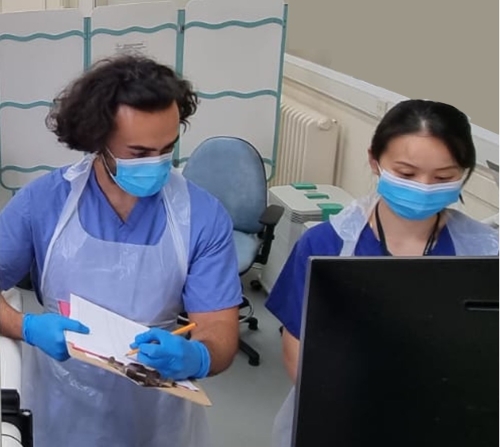4 September 2024
Professor James Hull, Zander Williams and the interventional bronchoscopy team at Royal Brompton have trialled a world-first method that allows clinicians to assess the movement of the large airways (i.e. trachea and main bronchi) during physical activity.
Traditionally, bronchoscopy is performed at rest and with people performing forced breathing out manoeuvres, but this new technique – termed continuous bronchoscopy during exercise (CBE) – permits an assessment of the airways during exercise.
We spoke to Zander Williams, a research physiologist, who led the trial.
Can you tell us about the assessment you trialled?
The study is the first ever report of the movement of the large airways during exercise. We are interested in this area because the current clinical practice to evaluate large airway movement (i.e. supine bronchoscopy or radiological studies) uses forced breathing out manoeuvres to assess the degree of large airway collapse. The airway response to these types of manoeuvres differs from the response to exercise.
In total, 25 healthy participants completed two research visits. At an initial visit, the CBE procedure was performed, which included an incremental walking exercise test to voluntary exhaustion with bronchoscope in situ. At the next visit, participants completed a forced expiratory MRI assessment. We then compared the results between the test methods.
What did the results tell you?
We have demonstrated the CBE technique can be undertaken in healthy participants and allows visualisation of the large airways during progressive exercise.
This assessment provides new insight regarding the structural behaviour and response of the trachea and main bronchi to exercise. We found relative stability of the large airways during progressive exercise, with no evidence of large airway collapse. In comparison, there was a marked difference when compared to MRI results, with almost two thirds of the cohort meeting the criteria for large airway collapse. The findings from this study challenge the conventional approaches of assessing large airway movement and the diagnostic criteria used.
What are the next steps?
Our next steps will be to undergo CBE in patients with suspected or a confirmed diagnosis of large airway collapse. We think it will provide new insight into the assessment of patients with unexplained breathlessness and provide a new method of visualising large airway movement during progressive exercise.
The study has been published in the Journal of Applied Physiology, a prestigious physiology journal. Read more about it here: Feasibility of continuous bronchoscopy during exercise in the assessment of large airway movement in healthy subjects | Journal of Applied Physiology
The project also won the Royal Brompton Annual Research Showcase (ARS) 2023 Most innovative award.
To find out more about our research, please contact us.
Read more research stories or sign up to the research newsletter.
